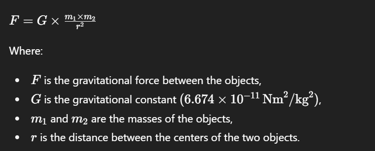Cosmic Bytes - Asteroids
What are some of the Asteroids monitored by NASA in this month (Oct'25)?
Asteroid 2023 TR1:
Size: 12 Feet (approx. the size of a car)
Closest Approach: 108,000 kilometers
Speed: 71,961 kilometers per hour
Asteroid 2023 TB1:
Size: 15 Feet
Closest Approach: 261,000 kilometers
Speed: 33,682 kilometers per hour
Asteroid 2023 TD1:
Size: 46 Feet (approx. the size of a house)
Closest Approach: 893,000 kilometers
Speed: 62,939 kilometers per hour
Asteroid 2023 TK:
Size: 43 Feet (approx. the size of a house)
Closest Approach: 2.21 million kilometers
Speed: 17,624 kilometers per hour
Asteroid 2023 TD:
Size: 31 Feet (approx. the size of a bus)
Closest Approach: 3.41 million kilometers
Speed: 33,848 kilometers per hour
How does the gravitational force between Earth and an asteroid depend on the asteroid’s mass and distance, and what factors determine whether the asteroid will be significantly influenced by Earth’s gravity or pose an impact threat?
The gravitational attraction between Earth and an asteroid depends on both the mass of the asteroid and its distance from Earth. The gravitational force between two objects is described by Newton's law of universal gravitation, which is given by the equation:


An asteroid will not necessarily be "attracted" to Earth in the sense of being pulled into a collision course simply because it comes close. It would need to pass within Earth's sphere of influence (SOI) to be significantly affected by its gravity. The radius of Earth's SOI is approximately 0.929 million kilometers. However, even within this region, an asteroid will not necessarily collide with Earth; it depends on its trajectory, speed, and other factors.
If an asteroid were to impact Earth, the effects would depend on its size, mass, composition, speed, and the angle of impact. Some potential impacts include the creation of an impact crater, release of a significant amount of energy (often compared to nuclear explosions), and environmental effects such as fires, tsunamis (if it lands in an ocean), and an impact winter (caused by debris thrown into the atmosphere, blocking sunlight).
It's worth noting that space agencies like NASA closely monitor Near-Earth Objects (NEOs) to predict any potential future impacts and develop possible mitigation strategies
